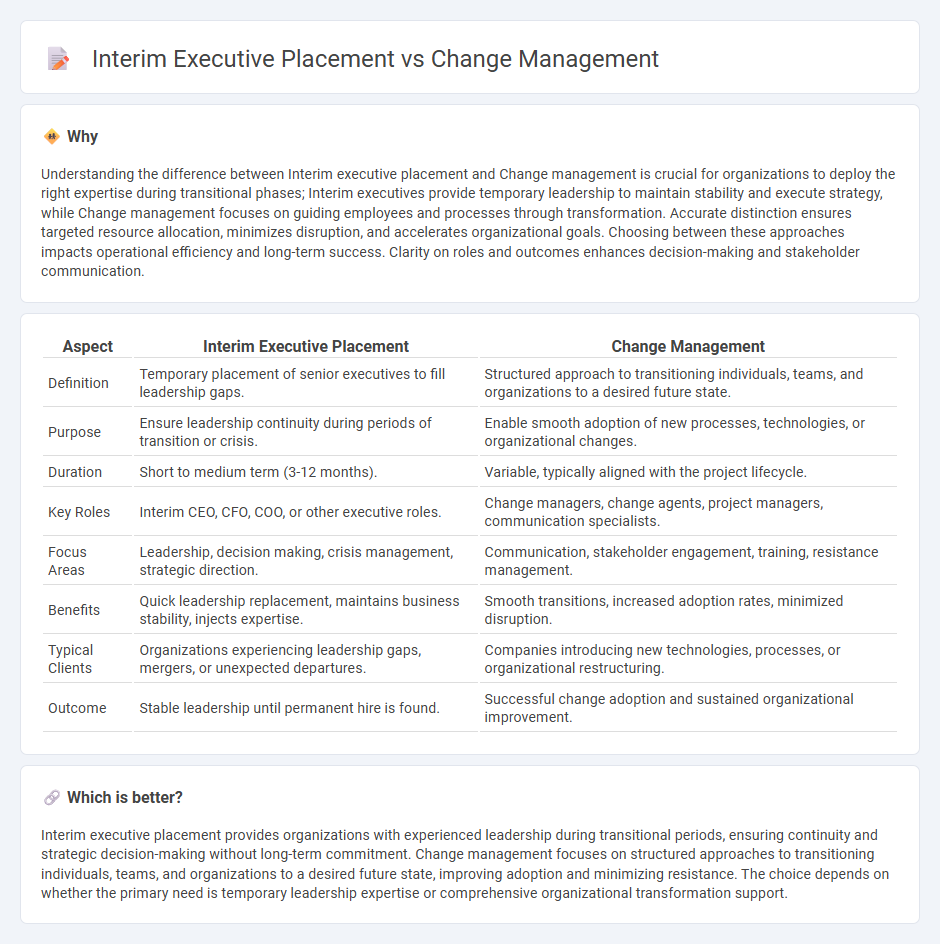
Interim executive placement involves temporarily assigning experienced leaders to fill critical roles during transitional periods, ensuring business continuity and strategic decision-making. Change management focuses on guiding organizations through transformation by addressing cultural shifts, employee engagement, and process realignment to achieve sustainable improvements. Explore how combining interim executive placement with effective change management can drive successful organizational transitions.
Why it is important
Understanding the difference between Interim executive placement and Change management is crucial for organizations to deploy the right expertise during transitional phases; Interim executives provide temporary leadership to maintain stability and execute strategy, while Change management focuses on guiding employees and processes through transformation. Accurate distinction ensures targeted resource allocation, minimizes disruption, and accelerates organizational goals. Choosing between these approaches impacts operational efficiency and long-term success. Clarity on roles and outcomes enhances decision-making and stakeholder communication.
Comparison Table
| Aspect | Interim Executive Placement | Change Management |
|---|---|---|
| Definition | Temporary placement of senior executives to fill leadership gaps. | Structured approach to transitioning individuals, teams, and organizations to a desired future state. |
| Purpose | Ensure leadership continuity during periods of transition or crisis. | Enable smooth adoption of new processes, technologies, or organizational changes. |
| Duration | Short to medium term (3-12 months). | Variable, typically aligned with the project lifecycle. |
| Key Roles | Interim CEO, CFO, COO, or other executive roles. | Change managers, change agents, project managers, communication specialists. |
| Focus Areas | Leadership, decision making, crisis management, strategic direction. | Communication, stakeholder engagement, training, resistance management. |
| Benefits | Quick leadership replacement, maintains business stability, injects expertise. | Smooth transitions, increased adoption rates, minimized disruption. |
| Typical Clients | Organizations experiencing leadership gaps, mergers, or unexpected departures. | Companies introducing new technologies, processes, or organizational restructuring. |
| Outcome | Stable leadership until permanent hire is found. | Successful change adoption and sustained organizational improvement. |
Which is better?
Interim executive placement provides organizations with experienced leadership during transitional periods, ensuring continuity and strategic decision-making without long-term commitment. Change management focuses on structured approaches to transitioning individuals, teams, and organizations to a desired future state, improving adoption and minimizing resistance. The choice depends on whether the primary need is temporary leadership expertise or comprehensive organizational transformation support.
Connection
Interim executive placement drives change management by providing skilled leaders who implement strategic transformations during periods of organizational flux. These executives bring expertise in navigating resistance, aligning teams, and accelerating adoption of new processes. Their temporary but focused leadership ensures seamless transitions and sustained performance improvements.
Key Terms
**Change management:**
Change management involves structured approaches to transitioning individuals, teams, and organizations from current to desired states, ensuring minimal disruption and sustained performance improvements. It focuses on communication strategies, stakeholder engagement, and training to embed new processes, technologies, or cultural shifts effectively. Explore our insights to understand how change management drives successful organizational transformation.
Stakeholder engagement
Effective stakeholder engagement in change management involves consistent communication, addressing concerns, and fostering collaboration to minimize resistance and ensure successful implementation. Interim executive placement enhances stakeholder confidence by providing experienced leadership who can quickly build trust and guide teams through transitional phases. Discover how aligning stakeholder engagement strategies with executive roles can drive organizational success.
Communication strategy
Effective communication strategy is critical in both change management and interim executive placement, ensuring clarity, alignment, and stakeholder engagement throughout transitional phases. Change management emphasizes transparent messaging to reduce resistance and foster adaptability, while interim executive placement relies on targeted communication to quickly establish trust and authority within the organization. Explore best practices for optimizing communication in these contexts to drive successful organizational outcomes.
Source and External Links
What is Change Management? - IBM - Change management is the structured approach organizations use to communicate, support, and implement change, focusing on both people and processes throughout transitions.
What is Change Management? Definition & Process - WalkMe - Change management is a coordinated, systematic process for handling the human aspects of organizational change, involving clear vision, planning, training, support, resistance management, and ongoing monitoring for sustainability.
What is Change Management? Organizational, Process ... - ASQ - Change management encompasses the methods and practices a company uses to describe, plan, and implement change in internal and external processes, emphasizing risk assessment, clear communication, and employee engagement.
 dowidth.com
dowidth.com